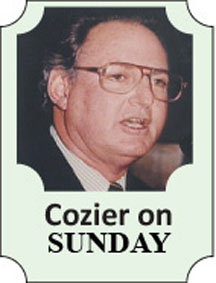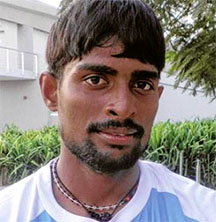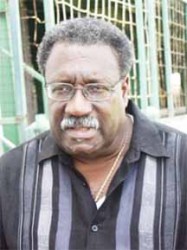Clive Lloyd’s brave new world of youth, alternatively the post-Chanderpaul era, is off to a rocky start.
Recognising the unmistakable signs from his previous six Test matches that Shivnarine Chanderpaul, the most experienced, most dependable and, significantly, oldest of modern day batsmen, had come to the end of his remarkable, 21-year career, West Indies’ chief selector Lloyd, with head coach Phil Simmons by his side, set out the plan for the future leading into the two Tests against Australia.
“Our aim is to continue to play our young players to give them exposure and you can’t get better exposure than playing against one of the best teams in the world,” he said. “They will be tested and that is what it’s all about”.

His level-headed defiance for 70, stretched over four hours as the West Indies battled to remain in contention, was a model to others, already seasoned in the demands of Test cricket, who didn’t measure up.
The Dominica result has left Lloyd, Simmons and their fellow selectors with some thinking to do in the few days leading into the second Test at Sabina Park on Thursday.
One concerns the opening position. Talented as he might be, Shai Hope had never gone in first in his short career when elevated in his debut Test against England in Barbados in May. It was asking too much of him.

Ravendra Chandrika, a specialist opener, was included in the squad but not in the 11 for the first Test, presumably on his strong regional first-class season rather than his modest overall record. The question is how to accommodate him, allowing Hope to revert to his accustomed slot in the middle order.
The spectre of the “I’m not retiring” Chanderpaul continues to hover in the background, even more so given the outcome of the first Test without him; Simmons, captain Denesh Ramdin and Jason Holder have all made the point that the team now needs to move on.
Whatever they do, the selectors can hardly abandon Lloyd’s plan after one match in which West Indies twice presented Australia with a challenge before slipping back into the frailty that has long since condemned them to No.8 among Test teams.
Brendon McCullum’s would be a practical template to follow.
The New Zealand captain overcame even more dire circumstances in his early series at the helm to build the Black Caps into the force they have become.
Three years ago, under Ross Taylor, they were soundly thrashed in the Caribbean, losing both Tests, four of the five ODIs and both T20s.

When Taylor was replaced, they were skittled for 45 by South Africa in McCullum’s first Test as captain; they succumbed by an innings in both Tests. They then lost both Tests in England in 2013, routed for 68 at Lord’s in the second innings.
Still McCullum, coach Mike Hesson and the selectors stuck with their players and their plans; seven of those beaten in the West Indies in 2012 were at Headingley last week, three years later, when they thumped England to level the series and maintain their No.3 spot in the Test rankings; it was a rapid leap from just above West Indies at seven.
Short of alternatives, Lloyd has no option but to take the same path. Coach Simmons, captain Ramdin and their emerging players are there to carry it out on the field. Time will be the decider; perhaps Lloyd can unearth more like Dowrich.
The Dominica capitulation, as was the case in the series in South Africa against Test cricket’s present top team in December and January, has let them appreciate what is required to achieve to start a climb back up the ladder.

They were undermined by unrelenting bowling and flawless, spectacular catching and ground fielding. They were constantly under pressure; the slightest lapse in concentration was seized on.
For a few hours into the second day, Davendra Bishoo brought them back into contention with six wickets in succession from high-class leg-spin.
The next day, Dowrich and Marlon Samuels, 10 years his senior and in his 58th Test, held firm in a fourth wicket partnership of 144 that inched the West Indies marginally ahead.
Neither effort could be sustained.
Among Bishoo’s six victims were such eminent masters of spin as Michael Clarke and Steve Smith.
Another was Brad Haddin, the dangerous wicket-keeper/batsman, who was utterly bamboozled by a fizzing leg-break that pitched leg and hit the top of off. Immediately compared to Shane Warne’s famed “ball of the century”, to Mike Gatting in the Old Trafford Ashes Test in 1993, it has quickly become “the ball of the 21st century”.
From 123 for six, Adam Voges, a 35-year-old belatedly on Test debut, accumulated an unbeaten 130 over five and a half hours; it was fashioned by a dozen seasons of tough Australian state cricket. Three tenacious bowlers stayed with him while 192 were added and the lead mounted to 170 as West Indian spirits sagged. It was not an unusual occurrence.
When both West Indies openers were swept aside for 25 by the end of the second day and the ever frustrating Darren Bravo drilled Josh Hazlewood for David Warner’s flying catch at mid-off in the sixth over on the third morning, another debacle appeared certain.
It was here that Dowrich appreciated the mental strength necessary to counter the Australians on a slow, if turning, pitch. His partner was Samuels. Into his 15th year of Test cricket, his experience renders him the natural successor to Chanderpaul as the leader of the batting, in experience if not character; seemingly aware of his new responsibility, he swapped his natural flamboyance for a more relevant method.
For 50 overs, there was hardly an error, rather a sensible balance between defence and attack. In his first Test, Dowrich vindicated Lloyd’s confidence.
The deficit was erased and the lead pushed to 11 with seven wickets in tact; if a contest appeared to be developing, those mindful of the West Indies’ inclination to inexplicable collapse remained wary.
Another duly arrived after Dowrich’s long vigil for 70 off 185 balls was ended with a catch off Hazlewood tapped to close-in mid-on. It was a crippling blow to the West Indies’ tender mid-section that swiftly dumped them onto the canvas.
None of Lloyd’s young brigade is more reckless than Jermaine Blackwood, none of the older hands more unpredictable than Samuels.
Blackwood’s default shot is a gully cricket slog. Sometimes he gets away with it, as through Jos Buttler’s missed stumping when he was 4 in his unbeaten 44 in the West Indies’ victory in the final Test over England in May. Now he didn’t; he was so far down the pitch to Lyon that Haddin could momentarily fumble and still stump him.
Samuels’ shot in the following over was equally outrageous. For 184 balls, he advanced with the restraint demanded of his station. In the over after Blackwood’s slog, he produced a replica of his first innings dismissal, a steepling hook into long-leg’s lap. It is impossible to determine what occupies Samuel’s mind at such times.
That was basically that as Australia were left with the formality to scoring 47 for their victory.
Twice over the three days, promising positions had been transformed into despondency for the West Indies. It’s enough to create panic in the selection room, a reaction Lloyd and his men can ill afford.





